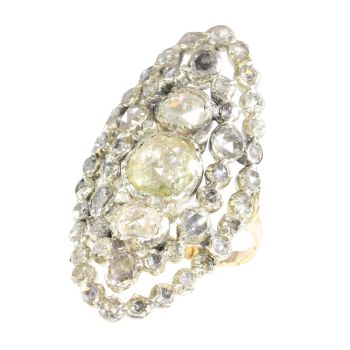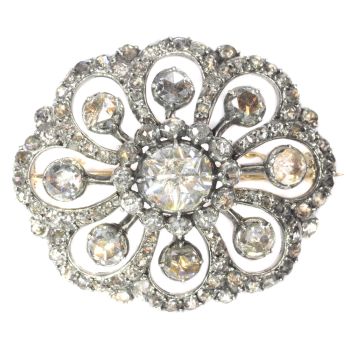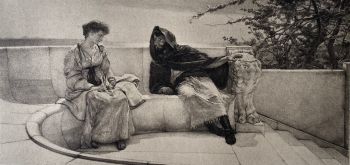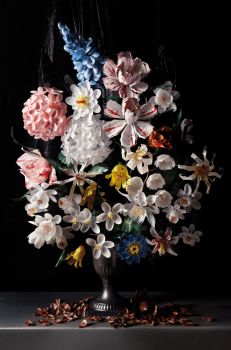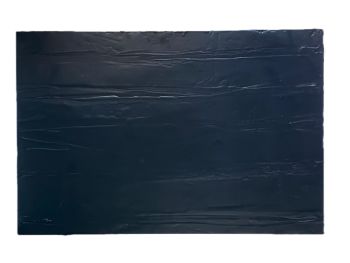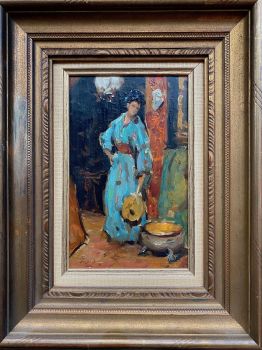At the shrine of Venus 1895
Lawrence Alma-Tadema
Photographic print
35 ⨯ 47 cm
ConditionVery good
€ 450
Gallerease Selected
- About the artwork
At the Shrine of Venus, original heliogravure after the painting (opus CCLXXXIX) by Sir Lawrence (Lourens) Alma-Tadema printed on heavy cream paper. Dimensions of the image: 20 cm by 25 cm Paperformat: 35 cm by 47cm Alma-Tadema has created an idealized image of the Classical Antiquity in a typically Victorian way. Alma-Tadema combines in an inimitable way storytelling with a sense of realism and keen eye for detail. He strenghtens his performances with archaeological erudition and historical reliability. We see here the interior of a Roman hairdressing salon where two young ladies are waiting be properly groomed. They are clearly ladies of good descent. To the left a lady walks past the bernacle of Venus (the marble table) to put a flower in front of the gifts wich are already present. Alma-Tadema self called At the Shrine of Venus his' powder-and-puff picture.
This photogravure is from the portfoliobook: "Laurence Alma Tadema, R.A. - A Sketch Of His Life And Work. With A Portrait, An Autograph, And Twenty-Two Illustrations." (London: Berlin Photographic Company) 1895, containing 22 reproductions of works by Tadema, including: a half title-page; a frontispiece showing the artist in his studio; another title-page with a printer's mark; a list of illustrations; a biography of the artist by F. G. Stephens; with head and tail-pieces; totale edition number of 400. Bound in cloth-covered binding inscribed with the title. - About the artist
Lawrence Alma-Tadema is one of the most highly renowned romantic artists of late 19th century Britain. He was born in the Netherlands as Laurens Tadema, to the family of the town notary. Later, as he tried to make his niche in the art world, he changed the spelling of his first name to the more English “Lawrence,” and included his middle name “Alma” as part of his surname, so he would be listed among the “A’s” in exhibition catalogues.
As a child, it was decided that Alma-Tadema would pursue the career of a lawyer, but he suffered a mental and physical breakdown when he was fifteen years old. He was diagnosed as consumptive, given a short time to live, and thus free to pursue a life of leisure and pleasure. Once left to his own devices, he decided to study art, as his mother had paid for art lessons in his earlier childhood and it was one of his interests. He regained his health and studied at the Royal Academy of Antwerp in 1852, where he won several respected awards. His first major work was exhibited in 1858, and it won much critical praise, and creating a sensation in the art world. By 1862, he set own in his own studio to pursue his individual career in art.
In 1869, Alma-Tadema lost his wife of six years to smallpox. Disconsolate and depressed, he ceased painting and his health was failing. Under the advice of his physician, he traveled to England for a medical diagnosis, where he was invited to the house of a fellow painter, Ford Madox Brown. It was here that he laid eyes on Laura Theresa Epps, who was 17 at the time, and fell madly in love with her. Alma-Tadema took advantage of the outbreak of the Franco-Prussian war to relocate to England, where he wasted no time contacting Laura and contracting her in private art lessons. It was during one of these lessons that Alma-Tadema proposed, and they were married shortly thereafter. Alma-Tadema was 34 years old, and the bride 18.
Alma-Tadema spent the next part of his life traveling through Europe, and enjoying the continued success of his paintings. As a man, his bursts of bad temper were eased by his extroverted, warm personality and sense of mischief. A perfectionist and obsessive worker, he also innovated a new numbering technique, which made it difficult for forgers to pass off unoriginal works. In his later years, although his artistic output decreased somewhat, he enjoyed continued success, eventually becoming one of the wealthiest painters of the 19th century. He was knighted in England in 1899.
In 1912, Alma-Tadema traveled to Germany to undergo treatment for stomach ulcer, and died in Germany at the age of 76. After his death, his work was mostly ignored. Due to the drastic changes taking place in art, Alma-Tadema’s artistic genius would not come into the public eye again until the 1960s. His meticulous work had since been used as source material for dozens of Hollywood movies.
Are you interested in buying this artwork?
Artwork details
Related artworks
- 1 - 4 / 12
- 1 - 4 / 24
Albert Clouard
Élégante à la cape (Elegant lady with a cloak)1866 - 1900
Prezzo su richiestaKunsthandel Pygmalion
JOHAN ANTONIE DE JONGE
A day on the beach of Scheveningen1885 - 1910
Prezzo su richiestaAdelwein Kunst
1 - 4 / 24Lawrence Alma-Tadema
"Caracalla and Geta: Bear Fight in The Coliseum, AD 203" 1907
Prezzo su richiestaGallerease Selected
 A cura di
A cura diDanny Bree
1 - 4 / 24- 1 - 4 / 24
- 1 - 4 / 12






















